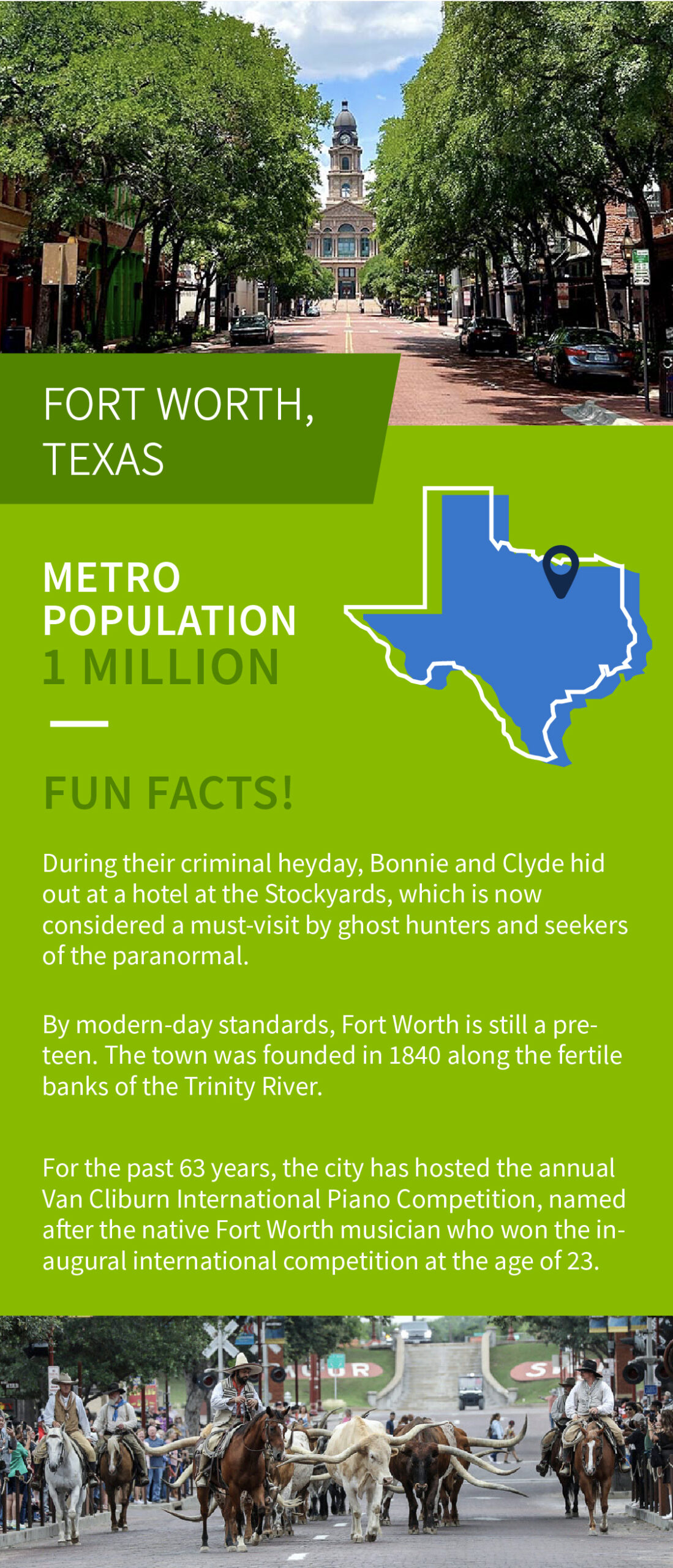Good Towns is a regular feature of Doing More Today, highlighting the people and places that make communities unique.
Big Jake is unfazed by the crowds. As people ogle and approach, it’s obvious he’s used to the attention. When you are a 2,100-pound bull, you can afford to be chill.
His human partner, Kaleb Sanders, is a young but veteran cowboy. And he’s proud of Big Jake. “He’s got four stomachs and two different digestive systems,” Sanders offers. The cost of feeding him year-round is astronomical, but you only need to spend a few minutes with Sanders and Big Jake to know the investment is wise.
It’s free to ride Big Jake – but the price is $10 for help with the dismount – which brings a chuckle to visitors who eagerly surround both sides of East Exchange Avenue, the bricked main road through the heart of the Fort Worth Stockyards. Twice a day, hundreds of people stand behind roped off barriers to see the cattle drive that brings a few dozen Texas Longhorns to their next destination.
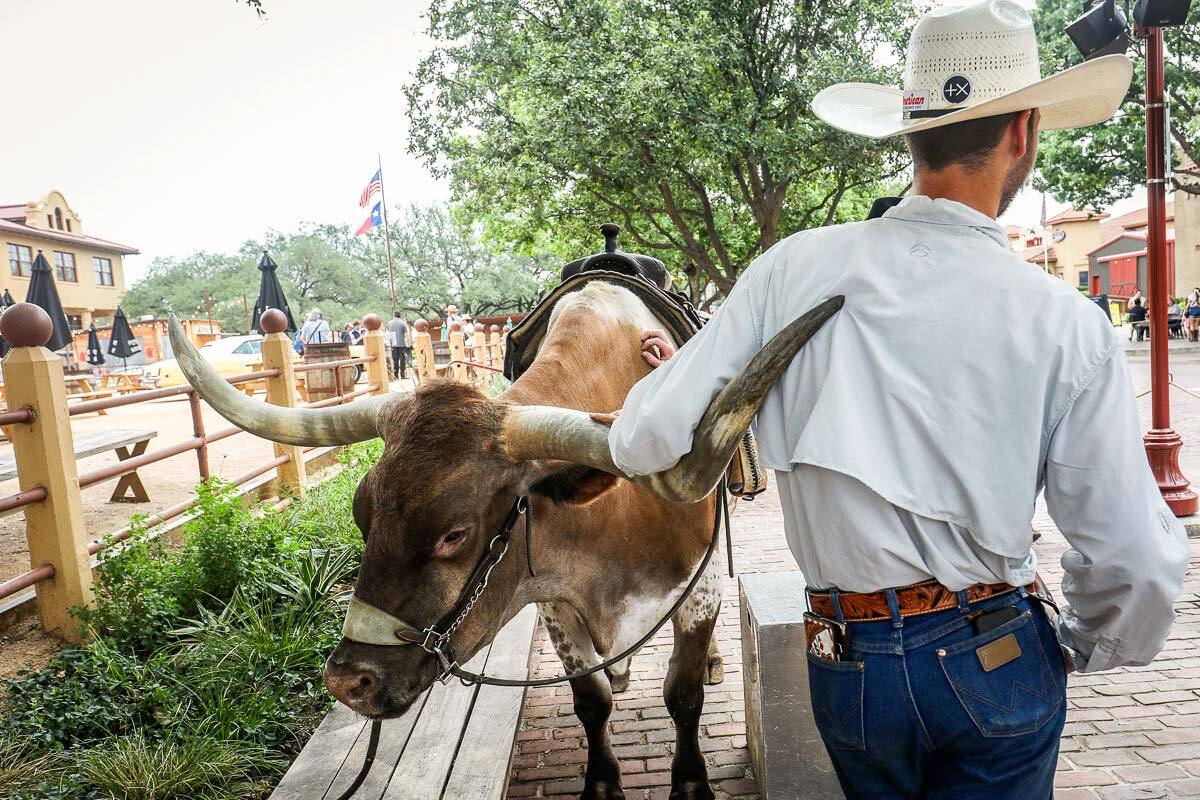
Big Jake waits patiently as Kaleb Sanders helps a Stockyard tourist prepare to climb aboard the beloved longhorn celebrity. / GARY TRAMONTINA PHOTOS

The bold, realistic Chisholm Trail Cattle Drive mural is a can't-miss stop at Sundance Square.

Twice a day, cowboys usher longhorn steers through the Stockyards, drawing big crowds.

Every day - at 11:30 a.m. and 4:30 p.m. - visitors to the Stockyard witness an authentic cattle drive, just like the ones on the old Chisholm Trail.

The day is late, but the cowboys have one last assignment: driving a herd of longhorns to their respective overnight accommodations at The Stockyard.

At the end of the workday, a solitary cowboy leads Big Jake back to his stall.

A canopy of trees provide perfect shade to those out for a noon walk downtown.

The famous Tarrant County Courthouse, built in 1895.
This isn’t merely a throwback to history. This IS the history of Fort Worth, aka Cow Town, where the West began. This was the key stop on the Chisholm Trail, which took longhorns from south Texas to Kansas, creating an economic driver that preceded oil in importance to the state’s flourishing coffers.
Welcome to our latest Good Town.
“Fort Worth is one of the biggest small towns you’ll ever want to be around,” said Brian Happel, Regions Bank’s market executive for the city. “The people are friendly, it’s easy to get around, and the culture is a great fit for anyone.”
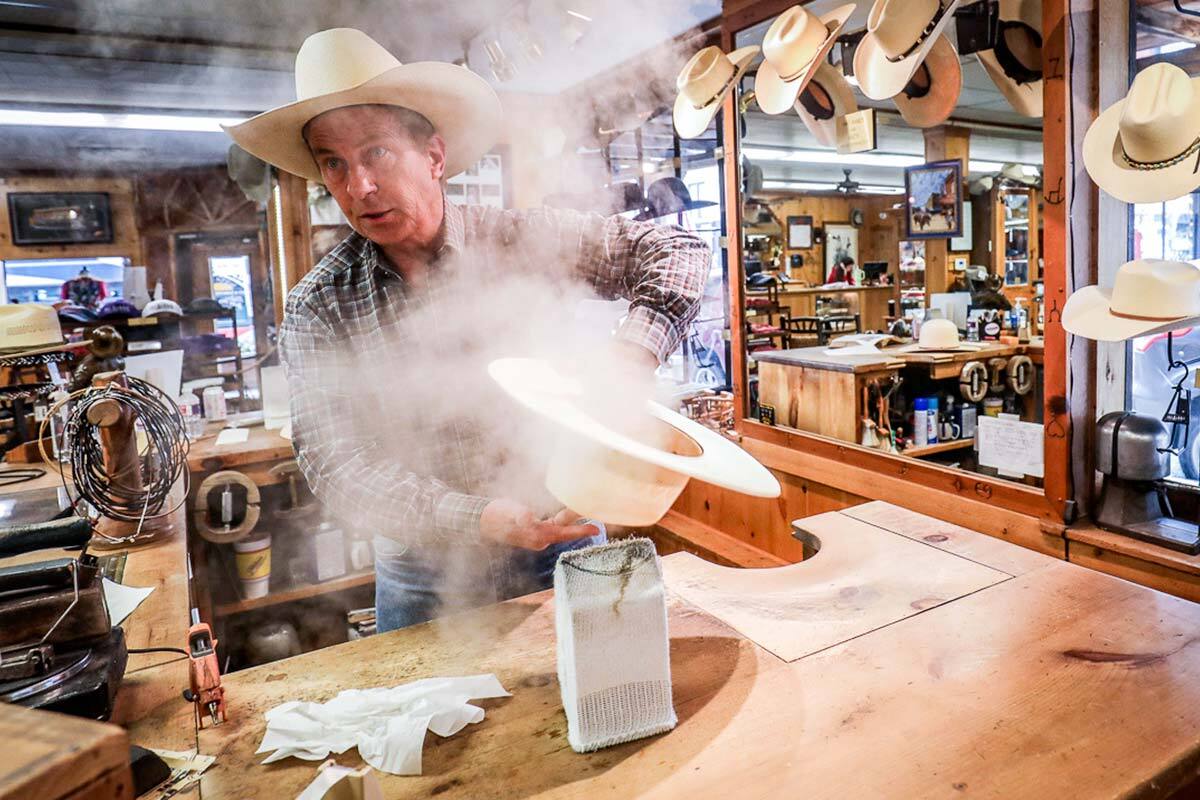
Joe Peters shapes a cowboy hat at M.L. Leddy's. If you're a fan of "Yellowstone" or "Landman," you've already seen his handiwork on the screen. / GARY TRAMONTINA PHOTOS

Rows of cowboys hats spill over to window displays at M.L. Leddy's.

Anything your favorite cowboy or cowgirl could want is stocked and available for purchase at the popular store.

Artisan Randy Valensin shows off a custom-made saddle at M.L. Leddy's.

At M.L. Leddy's, there's a saddle for every occasion.

M.L. Leddy's embossed stamp on a brand-new, hand-crafted saddle.

Tyler Campbell shows off a boot for sale at M.L. Leddy's.

Tyler Campbell shows off alligator skins available for fashioning a custom-designed cowboy boot.

A Longhorn caddy greets the daily herds at the Stockyards.

A delicious Trailboss cheeseburger, called The Herd, at the popular Stockyards restaurant.

A visitor crosses East Exchange Ave. Whether you go in search of fine dining, luxury shopping or souvenir photos, the Stockyards have it all.
Stockyards Fashion
Steam rises as Joe Peters Jr. uses the heat to shape a cowboy hat. This is a skill Peters has been perfecting for 40 years.
“You start with size and fit,” Peters said. “Once you get the right fit, you can put a shape into it. Hat shaping is an art, not a science – especially when you are on film and there are no filters. You have to be exact.”
Peters started at M.L. Leddy’s when he was 17. Most recently, he’s been working behind the scenes, helping Fort Worth native and show creator Tyler Sheridan get the right costumes and feel for his actors on “Yellowstone” and “Landman.”
“A lot of the clothes they wear came from here,” Peters said. “And I shaped all the hats. Let me tell you, Billy Bob (Thornton, ‘Landman’ star) is the real deal.”
Sitting behind a counter, Matt Shipman notes the impact of the television show on the entire city.
“’Yellowstone’ is the biggest thing for our economy since ‘Urban Cowboy,’” Shipman said.
Originally founded in Brady, Texas, M.L. Leddy’s has been a Texas icon for 103 years and is still owned by the same family, now four generations strong.
Upstairs, general manager Mark Dunlap shows us how custom saddles are made, showing off a photo of a pair George W. Bush presented to then-Prince Charles and Lady Camilla, both equestrians, on a royal visit to the White House.
Creating a custom-made cutting saddle can take 80-100 hours. It’s true craftsmanship that lures cowboys from across the world to visit M.L. Leddy’s.
Downstairs, Tyler Campbell shows off a pair of handcrafted boots. While the store boasts numerous employees who’ve spent their entire adult lives here, Campbell hails from Middle Tennessee, where his father was a well-known high school football coach.
“Fort Worth is the kind of place you visit and never want to leave,” Campbell said. “Everything you want is here.”
You could say the same about the Fort Worth Stockyards, which is one of the state’s top tourist attractions. The Stockyards drew nearly 11 million visitors in 2023, producing an economic impact exceeding $3 billion while tourism across the Metro employed 30,000 people. Everything you could want is here – restaurants and live music, museums and retail, television and radio studios, plus top-echelon places to stay, like the relatively new Hotel Drover.
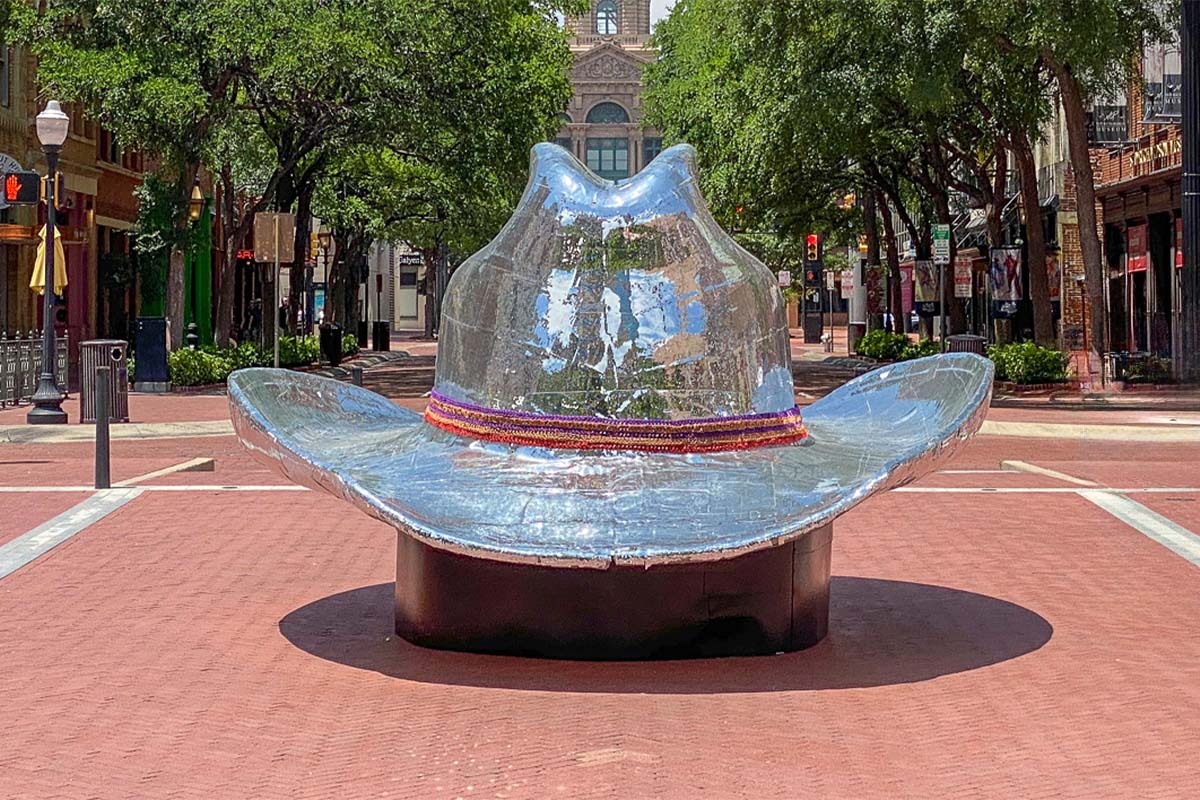
The Sundance Square Rhinestone Cowboy hat is a Fort Worth treasure. / GARY TRAMONTINA PHOTOS

The acoustics at the Bass Performing Arts Center are incredible. But before you even enter, a pair of 48-foot trumpeting angels greet you.

At the Modern Art Museum of Fort Worth, a family takes in the intricacies of a hand-made quilt.

Located in Fort Worth's Cultural District, the Modern Art Museum features multiple floors of exhibition space.

A pop art exhibition makes you think - and rethink - your initial feelings.

The iconic Iggy greets visitors near the entrance of the Fort Worth Zoo. Consistently ranked one of the nation's - if not the world's - best, the Fort Worth Zoo is also committed to protecting the endangered Texas horned lizard.

The entrance to Texas Christian University.

The backside of the video scoreboard at Amon G. Carter Stadium on the campus of TCU. The stadium, capacity 47,000, blends in perfectly with the academic buildings.

A volunteer looks on as a young summer visitor skips through the breezeway of one of nine historical venues at Log Cabin Village. At this site, one can experience early 19th Century life in Fort Worth.
Cosmopolitan Fort Worth Culture
At the heart of downtown Fort Worth is Sundance Square, where you are greeted by a giant, reflective cowboy hat sculpture, an incredible mural of the cattle drive, a plaza for coffee sipping and people watching, plus jetted water fountains providing a quick cool off from the humid heat.
This is Fort Worth’s cosmopolitan side, with walkable streets, accessible parking and plenty to choose from, including entertainment options ranging from comedy clubs to live theatre to the Bass Performance Hall, a nationally known center for the performing arts.
It’s easy to get around, and there’s a surprise around every corner. And nothing’s more surprising than the gleaming 45-foot-tall angel sculptures providing a heavenly clarion call from the front of the Bass Performance Hall.
We tour for a few hours, getting kudos from our smart watches for steps taken, and making plans to return for a spell on our next visit. But first we need to visit another beloved neighborhood, the Cultural District.
Give yourself a day, at least, because there’s so much to choose from, including great restaurants, exciting museums and art galleries and the Botanic Gardens. And in the middle of it all is the Fort Worth Zoo, one of the nation’s Top 10 zoos according to Conde Nast.
Just across University is Log Cabin Village, billed as Fort Worth’s living history museum, where school-age children roam the grounds soaking up the atmosphere guided by “pioneer” hosts garbed in 19th century attire.
Here, you’ll find the Foster House, a double-pen foxtrot home built prior to the Civil War, a blacksmith shop, a grist mill and the Marine School, an example of a one-room schoolhouse prevalent in the 1870s.
Traversing the village takes little time, but the contrast between historic and modern Fort Worth is there before your eyes. Because on the hillside above the village stand modern mansions leading to the campus of Texas Christian University, aka TCU.
A modern-day academic and athletic behemoth, TCU was founded in 1873 by brothers Addison and Randolph Clark and now features an enrollment of almost 11,000 students. The campus covers 302 acres yet remains compact and walkable, and the surrounding neighborhood gives it a feel of a college town despite Fort Worth’s size.
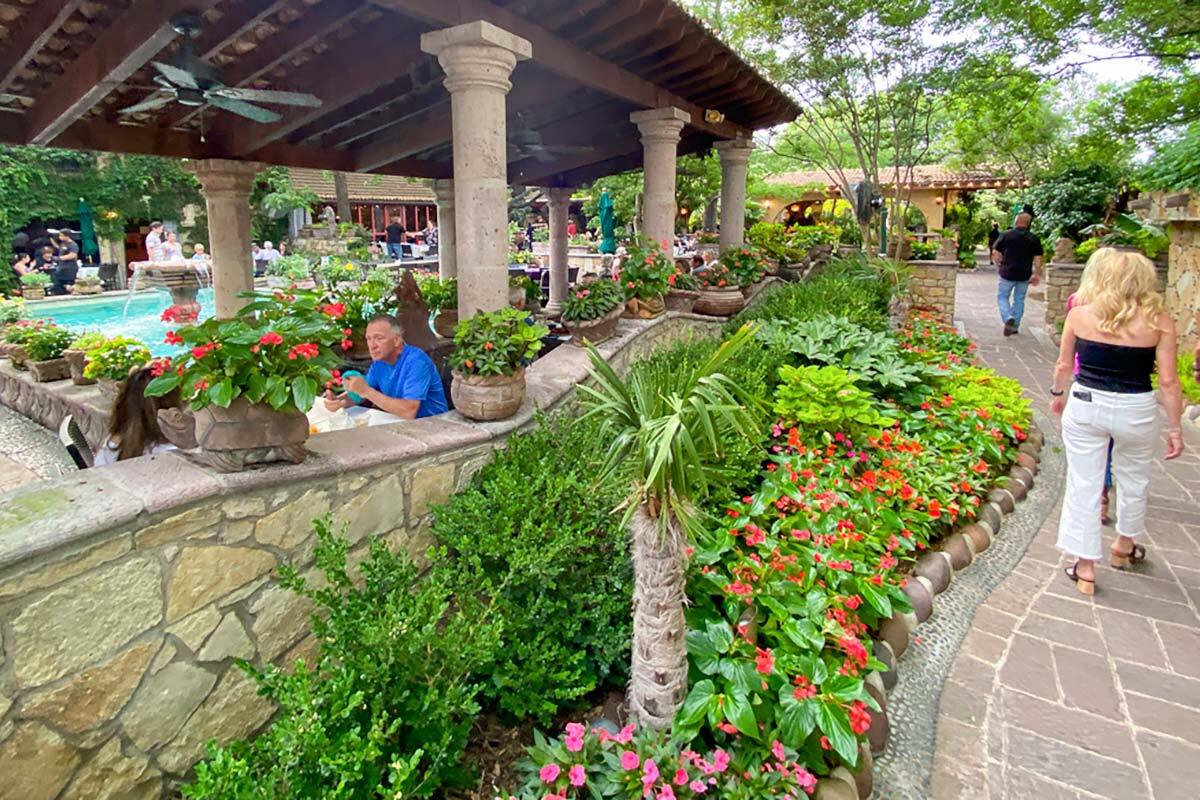
Tropical gardens, water features and a stone path lead customers at Joe T. Garcia's to dinner in the courtyard. / GARY TRAMONTINA PHOTOS

At Joe T. Garcia's, family-sized outings are the norm for patio dining. The food is great and the tropical surroundings are breathtaking.

A piping hot entree, where taste and smells stir the soul, at Joe T. Garcia's.

The Salvatore brothers grew up in McAllen, Texas, but their restaurant is the fulfillment of a dream their father fostered when they were children. Here, Chef Allesandro Salvatore and General Manager Julian Castro greet visitors.

Delicious eggplant at Bocca Osterio Romana.

A plate of delectable gnocchi at Bocca Osterio Romano.

Noah Bass, the Chief Operating Officer of Best Maid Pickles.

Seasoned to perfection then readied for shipping, Best Maid Pickles travel along the conveyor belt.

At Best Maid, an employee carefully ensures that the best pickles make it to jars headed to stores across the region.

The conveyor belt moves jars of Best Maid pickles in rows of five as far as the eye can see.

Large containers of Best Maid hamburger-slice dill pickles await transport to customers.
Tex-Mex, Taste of Rome and the ‘Real Dill’
You’d expect great Tex-Mex food throughout Fort Worth, but when you arrive at Joe T. Garcia’s it’s more than the food. It’s an experience.
For a leisurely dinner in the courtyard of this century-old eating destination, you’re taken on a meandering walkway past lush plants and whimsical fountains. It seems like every table sits a large gathering. Why not? This is a communal experience, celebrating friends and remarkable food.
It’s a tradition that began in 1911, when Mamasuez migrated from Mexico to Fort Worth. With her husband, Joe T. Garcia, they built a modest restaurant that became a culinary institution. Even on a weeknight, the line outside the door stretches around the corner.
In the brick-town neighborhood known as the Historic Near Southside, you’ll find another unique dining experience at Bocca Osteria Romana, where the Italian dishes feel like they were flown in directly from across the pond. During our visit, we received the grand tour from General Manager Julian Castro, who filled us in on the Salvatore brother’s vision.
For brothers Alessandro and Alfonso Salvatore, Bocca Osteria Romana is the fulfillment of a dream they shared growing up in McAllen, Texas and a homage to their late father. But before setting roots in Fort Worth, they lived in Italy and in Puerto Rico, where they learned the ropes at their first three San Juan concepts, including the original Bocca Osteria.
The Fort Worth location is a relative newcomer but has quickly gained local support, recently earning Fort Worth’s ‘Best New Restaurant of the Year’. On the night we visited, patrons ate in a courtyard adorned with Italian flare as the scent of fresh pasta and focaccia filled the air. But the biggest obstacle is this: do you take time to enjoy your meal or spend more time looking with wanderlust at the dish arriving at the next table over? Decisions, decisions.
Texans love their food. That’s why Best Maid Pickles is an iconic brand throughout the region. In fact, this brand is so popular that it offers its own stand-alone Pickle Emporium, where you can buy everything from food to swag, including colorful “Big Dill” T-shirts.
But instead of going retail, we went in search of the nitty gritty of how the deliciousness is made. At the Best Maid factory, we meet up with Chief Operating Officer Noah Bass, who gives us a tour of the facility.
Bass started life as a salesman after graduating from the University of Arkansas. He joined Best Maid 23 years ago and now oversees the process from creation to distribution. And there’s not a second to waste.
“We start planting at the end of May then start harvesting in July,” Bass explained. “Cucumbers grow so quickly at the end of the 45- to 50-day growth window we only have 24 hours to get them harvested at the right size”.
Fifty percent of the Best Maid cucumbers come from farms in West Texas. So, they start with impressive stock. But it’s the treatment upon arrival at the factory that makes the biggest difference.
“Best Maid pickles are best known for their dill flavor,” Bass said. “They are saltier and stronger – a great fit for this region.”
They sell under the name of multiple brands, including private labels for high-end grocers. While taste is a definite selling point, so is shelf life.
“Pickles are the safest items in all of food production,” Bass added. “Because the PH level is below 4.6, it doesn’t allow bacteria to grow.”
Best Maid started with salesmen going door to door. Now, the company is closing in on its own centennial. Like Fort Worth, it’s an underrated gem. And that’s something Bass appreciates about the Good Town he calls home.
“That’s what I love about Fort Worth. It’s the biggest small town around. You can get anywhere in 10 minutes, and anything you could want is here.”
